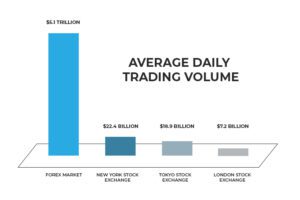How Big Is The Forex Market?
Deaching of the great explorer of the truth the builder
-
BEGINNER LEVEL

-

How Big Is The Forex Market?
The average per day volume of trade in the Forex market, as mentioned before, is a whopping $5.1 Trillion according to a 2016 report. That’s more than any other trade in the world, including the New York Stock Exchange which has a daily turnover of $22.4 billion a day.
So, where exactly is this market and how can one access it? The answer to the first you probably already know as it was explained in Lesson 1 but to reiterate it here, it exists all over the world.
Some of the most active centers are located in London, New York, Tokyo, Singapore, Zurich, Hong Kong, Sydney, and Paris. Since these centers function in different time zones, it means that the market is open 24 hours. By the time the 9-5 shift ends in one place it has begun in another. It means that trading never actually stops. This goes on for 5 days a week.
In order to access the Forex market all you need is a trading account and an internet connection.
The easy accessibility of Forex as well as the lack of one solid office/center is because it is an Over-the-Counter (OTC) market. This means that instead of a centralized exchange, trades take place through a broker or dealer. There is no regulatory authority.
Investing in Forex is different from investing in stocks in that traders are not betting on a company to do well. They invest in entire countries’ economies.Economies are affected by a number of factors for e.g. the interest rate, the political environment and of course GDP etc. So investing in Forex requires a basic understanding of economics.
Being an OTC market means there are fewer restrictions and rules as there is no regulatory authority overseeing everything. However, it then also means that brokers/dealers and all other players can be inventive with the way they earn their profits so one has to be careful when hiring a service.
Accessing the Market
Each trader hires a broker who provides them access to the market. They initiate and close trades for the traders and also facilitate margin trading. Some brokers also offer consultation services and can help beginners understand the market.
Broker lists can be found on many online directories.
Now that you know what FX trading is mainly about and its background, we can move on to the technical part and perhaps a bit of the nitty gritty.
The first thing you need to know is how to read a quote. It is the basis of all trading, after all.







